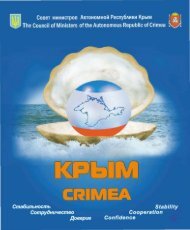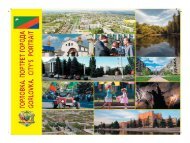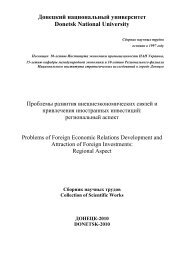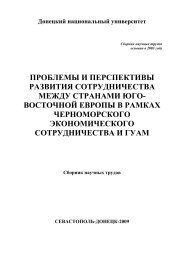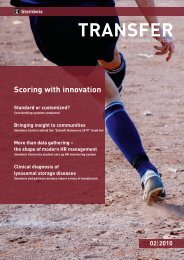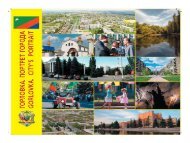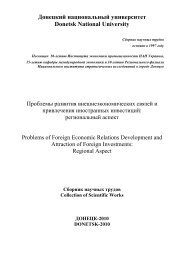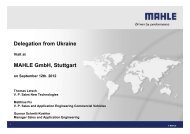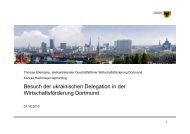56Проблемы развития внешнеэкономических связей и привлечения иностранных инвестиций: региональный аспект, 2010• Cost Estimate for FEL 2 StageThe FEL 1 stage typically takes 2-3 months to complete. The costs for this stage are quite minimal and depending on the size of the project, a project team of 1-2 persons can complete this stage.FEL 2 StageListed below are key Characteristics of the FEL 2 Stage. The goal of the FEL 2 stage is develop general engineering documentation and high levelsimplementation plans and schedules. Based engineering drawings and schematics are completed, and the location of the buildings and main equipment arefrozen.Commonly known as Pre-Feasibility Study• Cost estimate +/- 20%• Determination of production program and capacity calculations• Analyze and select technology• Review availability of raw material and components• Availability of Energy resources• Availability of Human Resources (operation / construction)• Review of Safety and Environmental Issues (Start EIA and SIA processes).• Initial Geotechnical Investigations Conducted• Develop Draft Project Execution Plan• Develop High Level Logistics Plan• Issue technical specification to equipment suppliers and review bids for main equipment• Review bids and prepare recommendation for main equipment supplier• Prepare list of long lead itemsDepending on the size and scope of the project, an FEL project team can have as few as 2 people or as many as 20. During this phase of the project, althoughthe main technology has been selected, the main equipment supplier is not usually selected until the end of the stage. Early in the stage, a technical specificationis issued to potential main equipment suppliers so that they can prepare bids. The bids are reviewed, and a recommendation for main equipment supplier isprovided to management. This can be done at the end of the FEL 2 phase, or just prior to the end of the phase. In order to begin the FEL 3 stage, it is necessaryto have the main equipment supplier selected. This is required to complete the detailed engineering as well as order long lead items.FEL 3The FEL 3 stage is final stage before FID, in which detailed engineering, planning and cost calculations occur. The main equipment supplier has been selected,and potential construction companies are assessed, and in some cases a construction partner is also selected.• Commonly known as Feasibility Stage• Cost estimate +/- 10%• Detailed production program and capacity calculations.• Detailed list of mechanical, electrical, automation components.• Order long lead items• Confirm equipment suppliers• Develop detailed construction plan and cost estimate• Detailed Procurement Plan• Detailed review of Safety and Environmental Issues (EIA’s and SIA’s completed at end of FEL 3).• Detailed Geotechnical Investigations and Surveys Conducted• Detailed Logistics Plan including Simulations (Examples)• Project Execution Plan FinalizedDetailed engineering drawings are completed, a detailed construction plan and schedule is developed and reviewed by construction experts and key permitsrequired for the project to proceed are obtained. These include, but are not limited to, the Environmental Impact Assessment (EIA) and Social ImpactAssessment (SIA). These must be completed prior to FID, because if management is going to approve the project, they must know that the project has approvalfrom the required authorities.Capital Cost EstimateFID documentation is prepared with detailed capital cost estimates. The quantities of each construction material is calculated and the cost estimated (steel,concrete, piping, etc). Labor is calculated based on the trades required and their hourly rate. Shut down costs (if required) are also calculated (ie productionlosses due to shut down of rolling mill while new equipment is installed).The capital cost estimate is broken down into 3 main section; equipment costs, direct costs and indirect costs.Equipment costs are costs for main process equipment based on fixed pricing or contracts already in place. These prices are considered fixed unless there arestipulations in the contract stating the prices can change.Direct Costs are composed of direct construction and erection costs, for example: materials, erection of main equipment, additional equipment not supplied bymain equipment suppliers (cabling, piping, etc) and demolition costs.Indirect Costs are comprised of Project Management Costs, Commissioning and Training Costs and Customs and Shipping.In a typical Western Project, the cost breakdown would be as follows:Main Equipment – 40%Direct Costs- 30%Indirect Costs- 30%The cost breakdown is also very dependent on if the site is Green Field (new site and therefore new buildings/utilities are required) or Brown Field (constructedwithin existing building or process). A Green Field project will have much higher direct costs then a Brown Field site where most of the cost will be for mainequipment.Based on experience on project in CIS countries, the indirect costs are usually closer to 20% based on cheaper labor. However cost estimate received from theDesign Institutes have indirect costs closer to 10%, which is very unrealistic and this has been proven on many projects.For a recently estimated project in the CIS, the Capital Cost Estimate was broken down as follows:Main Equipment – 55%Direct Costs- 25%Indirect Costs- 20%After the capital cost estimate, the financial justification is completed. The exact methodology and calculations/model used will depend on the clients process.Typically, the following items are listed in the justification: Capital costs Capital costs less sunk cost NPV 10years + residual value Project IRR Project DPP Project PBNPV (Net Present Value) is cash inflows from the project excluding money value and risk extra payment. From the mathematical point of view, NPV is totaldiscounted cash flows of the project.
Проблемы развития внешнеэкономических связей и привлечения иностранных инвестиций: региональный аспект, 2010The Project IRR (Internal Rate Of Return) is such a discount rate value (r), at which the project NPV amounts to zero. In other words IRR shows themaximum interest rate, at which an investor can allocate investments for the project, in order to ensure return on investments at this interest rate.The Project PB (Payback Period) refers to a period of time since embarking on project financing which is required for covering all investment costs onaccount of cash flows generated under the project. In simple terms, PB shows that moment since commencement when investor is to pay back its project costscompletely, taking into account obtaining required return. Since this moment all additional project income is additional bonus for investor.The Project DPP (Discounted Payback Period) is a type of PB, which refers to a period of time since embarking on project financing when all discountedinvestment costs will be covered by discounted cash flows generated under a project.A sensitivity analysis is also performed to determine how a change in a project factor affects the NPV; for example Capital Cost, Margin, Increase/Decrease inProduction or Shut Down period. Others may be added as required.FEL 4The FEL 4 stage is the execution or construction phase. The main highlights are as follows:• The Project Execution Phase includes design and engineering for construction, manufacturing, erection and commissioning of theequipment/facility.• The success of this stage depends strongly on two items-– The prior 3 stages being completed thoroughly and accurately– The project manager taking ownership and responsibility for the success of the project. They must have the authority to make keyproject decisions.• The construction contractor must be brought into the process early on as part of the project team.• A cost control system / strategy will be implemented tracking costs and providing reports.• Frequent update meetings with project manager and their key staff. Communications is critical for success. If one department is behind orstruggling it must advise the team as to not affect the whole project and to develop a solution.• Training is very important to ensure employees are prepared to use new equipment and avoid problems on start-up.• Integration and testing of IT equipment should be done in off-line in advanceThe FEL 4 stage is generally managed by a large on site project team of many disciplines. The project manager has complete authority over the project, andprovides weekly or monthly updates to a management steering committee. Organization and planning are critical to ensure success, for example on aninstallation during a major mill shutdown, the construction schedule must be broken down into hourly increments.Project ManagementThere are many companies in the West that specialize in EPCM (Engineering and Project Management). The will develop all the documentation for the FELstages up to FID and also manage the execution phase. As major corporations reduce their own Engineering and Project Management Departments to cutoverhead costs, the use of outside project management companies has increased. All the costs associated with the project can be clearly identified and if thereare no projects being developed, corporations are not paying for their staff to be idle.Project Management does not only mean Engineering but includes many other key items:– Safety– Quality– Cost Controls– Logistics– Scheduling– Human Resources– Selection of Main Equipment Suppliers– Technology SelectionSafety in Project ManagementSafety is the number one priority on any project- it is not acceptable to have anyone hurt or killed on a project. During the feasibility phases, HAZOP (HazardOperations) reviews are conducted to where possible, engineer out any significant risks to employees. Each vendor and contractor is assessed based on theirpast safety performance; those with poor records are not used on the project. During the construction phase, frequent safety meetings are conducted and anonsite safety manager ensures construction work is conducted in a safe manner.Advantages to Project ManagementThe initial cost of using a professional project management company appears high, but there are many advantages and long term cost savings. First andforemost, having the project completed on time and on budget.The main advantage to Project Management is having one person/group take responsibility for the entire project ensuring effective communication and makingtimely decisions. Developing a detailed plan is critical to the execution- even the best companies will not have successful projects without proper planning. Aextension in a mill shut down for an installation can result in millions of dollars a day in losses..Project costs are continually monitored and reported to ensure adherence to plan. Any additional costs must be approved by the Project Manager, or if there aresubstantial cost increases from the FID price, the additional costs must be approved by Senior Management before the project moves forward.The project schedule undergoes regular reviews and updates. It is too late to update a schedule after a deadline has passed. It is better to adjust the schedule andadvise the affected parties than to wait and miss the deadline which may impact many other activities.Using a professional project management company also ensures the best available equipment and technology is selected. The project management companywill select the best technology however the customer generally has the final decision on who is selected as main equipment supplier.ConclusionUsing a project development process that uses a Front End Loading concept significantly improves the accuracy of the capital cost estimate and projectschedule used for the Final Investment Decision.Although it can initially appear expensive, the use of a professional project management company will significantly improve project development andimplementation, which will result in significant savings in the long term.РЕЗЮМЕВ статье рассмотрены вопросы управления проектами в аспекте различий между западным и восточными подходами.РЕЗЮМЕУ статті розглянуті питання керування проектами в аспекті розходжень між західним і східним підходами.SUMMARYIn article questions of management by projects in aspect of distinctions between western and east approaches are considered.57
- Page 1 and 2:
Донецкий националь
- Page 3 and 4:
Редакционная колле
- Page 5 and 6: Проблемы развития
- Page 7 and 8: Проблемы развития
- Page 10 and 11: Проблемы развития
- Page 12 and 13: 12Проблемы развития
- Page 14 and 15: Проблемы развития
- Page 16 and 17: Проблемы развития
- Page 18 and 19: 18Проблемы развития
- Page 20 and 21: Проблемы развития
- Page 22 and 23: Проблемы развития
- Page 24 and 25: Проблемы развития
- Page 26 and 27: 26Проблемы развития
- Page 28 and 29: Проблемы развития
- Page 30 and 31: Проблемы развития
- Page 32 and 33: Проблемы развития
- Page 34 and 35: Проблемы развития
- Page 37 and 38: Проблемы развития
- Page 40 and 41: 40Проблемы развития
- Page 42 and 43: Проблемы развития
- Page 44 and 45: Проблемы развития
- Page 46 and 47: 46Проблемы развития
- Page 48 and 49: 48Проблемы развития
- Page 50 and 51: Проблемы развития
- Page 52 and 53: Проблемы развития
- Page 54 and 55: Проблемы развития
- Page 58 and 59: Проблемы развития
- Page 60 and 61: РКрим А і н ницькаВ
- Page 62 and 63: Проблемы развития
- Page 64 and 65: содействия поФондМ
- Page 66 and 67: Проблемы развития
- Page 68 and 69: 68Проблемы развития
- Page 70 and 71: 70Проблемы развития
- Page 72 and 73: Проблемы развития
- Page 74 and 75: Проблемы развития
- Page 76 and 77: 76Проблемы развития
- Page 78 and 79: 78Проблемы развития
- Page 80 and 81: 80Проблемы развития
- Page 82 and 83: Проблемы развития
- Page 84 and 85: 84Проблемы развития
- Page 86 and 87: Проблемы развития
- Page 88 and 89: Проблемы развития
- Page 90 and 91: Проблемы развития
- Page 92 and 93: Проблемы развития
- Page 94 and 95: Проблемы развития
- Page 96 and 97: Проблемы развития
- Page 98 and 99: 98Проблемы развития
- Page 100 and 101: Проблемы развития
- Page 102 and 103: 102Проблемы развити
- Page 104 and 105: Проблемы развития
- Page 106 and 107:
Проблемы развития
- Page 108 and 109:
Проблемы развития
- Page 110 and 111:
Проблемы развития
- Page 112 and 113:
Проблемы развития
- Page 114 and 115:
60000700004000050000200003000001000
- Page 116 and 117:
Проблемы развития
- Page 118 and 119:
Проблемы развития
- Page 120 and 121:
Проблемы развития
- Page 122 and 123:
Проблемы развития
- Page 124 and 125:
Проблемы развития
- Page 126 and 127:
Проблемы развития
- Page 128 and 129:
01 ж ивi тварини55 хiмi
- Page 130 and 131:
Проблемы развития
- Page 132 and 133:
Проблемы развития
- Page 134 and 135:
Проблемы развития
- Page 136 and 137:
136Проблемы развити
- Page 138 and 139:
Проблемы развития
- Page 140 and 141:
Проблемы развития
- Page 142 and 143:
Проблемы развития
- Page 144 and 145:
Проблемы развития
- Page 146 and 147:
Проблемы развития
- Page 148:
Проблемы развития
- Page 151 and 152:
Проблемы развития
- Page 153 and 154:
Проблемы развития
- Page 155 and 156:
Проблемы развития
- Page 157 and 158:
Проблемы развития
- Page 159 and 160:
Проблемы развития
- Page 161 and 162:
Проблемы развития
- Page 163 and 164:
Проблемы развития
- Page 165 and 166:
Проблемы развития
- Page 167 and 168:
Проблемы развития
- Page 169 and 170:
Проблемы развития
- Page 171 and 172:
Проблемы развития
- Page 173 and 174:
Проблемы развития
- Page 175 and 176:
Проблемы развития
- Page 177 and 178:
Проблемы развития
- Page 179 and 180:
Проблемы развития
- Page 181 and 182:
Проблемы развития
- Page 183 and 184:
Проблемы развития
- Page 185 and 186:
Проблемы развития
- Page 187 and 188:
Проблемы развития
- Page 189 and 190:
Проблемы развития
- Page 191 and 192:
Проблемы развития
- Page 193 and 194:
Проблемы развития
- Page 195 and 196:
Проблемы развития
- Page 197 and 198:
Проблемы развития
- Page 199 and 200:
Проблемы развития
- Page 201 and 202:
Проблемы развития
- Page 203 and 204:
4748,14039,3Проблемы раз
- Page 205 and 206:
Проблемы развития
- Page 207 and 208:
Проблемы развития
- Page 209 and 210:
Проблемы развития
- Page 211 and 212:
Проблемы развития
- Page 213 and 214:
Проблемы развития
- Page 215 and 216:
Проблемы развития
- Page 217 and 218:
Проблемы развития
- Page 219 and 220:
Проблемы развития
- Page 221 and 222:
Проблемы развития
- Page 223 and 224:
Проблемы развития
- Page 225 and 226:
Проблемы развития
- Page 227 and 228:
Проблемы развития
- Page 229 and 230:
Проблемы развития
- Page 231 and 232:
Проблемы развития
- Page 233 and 234:
Проблемы развития
- Page 235 and 236:
Проблемы развития
- Page 237 and 238:
Проблемы развития
- Page 239 and 240:
Проблемы развития
- Page 241 and 242:
⌢Проблемы развити
- Page 243 and 244:
Проблемы развития
- Page 245 and 246:
Проблемы развития
- Page 247 and 248:
Проблемы развития
- Page 249 and 250:
Проблемы развития
- Page 251 and 252:
Проблемы развития
- Page 253 and 254:
Проблемы развития
- Page 255 and 256:
Проблемы развития
- Page 257 and 258:
Проблемы развития
- Page 259 and 260:
Проблемы развития
- Page 261 and 262:
Проблемы развития
- Page 263 and 264:
Проблемы развития
- Page 265 and 266:
Проблемы развития
- Page 267:
−−−−Проблемы раз
- Page 270:
Проблемы развития
- Page 273 and 274:
Проблемы развития
- Page 275 and 276:
Проблемы развития
- Page 277 and 278:
Проблемы развития
- Page 279 and 280:
Проблемы развития
- Page 281 and 282:
Проблемы развития
- Page 283 and 284:
Проблемы развития
- Page 285 and 286:
Проблемы развития
- Page 287 and 288:
Проблемы развития
- Page 289 and 290:
Проблемы развития
- Page 291 and 292:
Проблемы развития
- Page 293 and 294:
Проблемы развития
- Page 295 and 296:
Проблемы развития
- Page 297 and 298:
Проблемы развития
- Page 299 and 300:
Проблемы развития
- Page 301 and 302:
Проблемы развития
- Page 303 and 304:
Проблемы развития
- Page 305 and 306:
Проблемы развития
- Page 307 and 308:
Проблемы развития
- Page 309 and 310:
Проблемы развития
- Page 311 and 312:
Проблемы развития
- Page 313 and 314:
Проблемы развития
- Page 315 and 316:
Проблемы развития
- Page 317 and 318:
Проблемы развития
- Page 319 and 320:
Проблемы развития
- Page 321 and 322:
Проблемы развития
- Page 323 and 324:
Проблемы развития
- Page 325 and 326:
Проблемы развития
- Page 327 and 328:
Проблемы развития
- Page 329 and 330:
Проблемы развития
- Page 331 and 332:
Проблемы развития
- Page 333 and 334:
Проблемы развития
- Page 335 and 336:
Проблемы развития
- Page 337 and 338:
Проблемы развития
- Page 339 and 340:
Проблемы развития
- Page 341 and 342:
Проблемы развития
- Page 343 and 344:
Проблемы развития
- Page 345 and 346:
Проблемы развития
- Page 347 and 348:
Проблемы развития
- Page 349 and 350:
Проблемы развития
- Page 351 and 352:
Проблемы развития
- Page 353 and 354:
РАЗВИТИЕ ВНЕШНЕЭКО
- Page 355 and 356:
Морозова О.В. ДИСБА
- Page 357 and 358:
УКРАИНЕШумак Ж.Г.ПР
- Page 359 and 360:
КРИЗИВорошилова Г.
- Page 361 and 362:
Именной указатель/
- Page 363 and 364:
Костенко Н.В. 1 71Кош
- Page 365 and 366:
Ступницький О.І. 3 784





